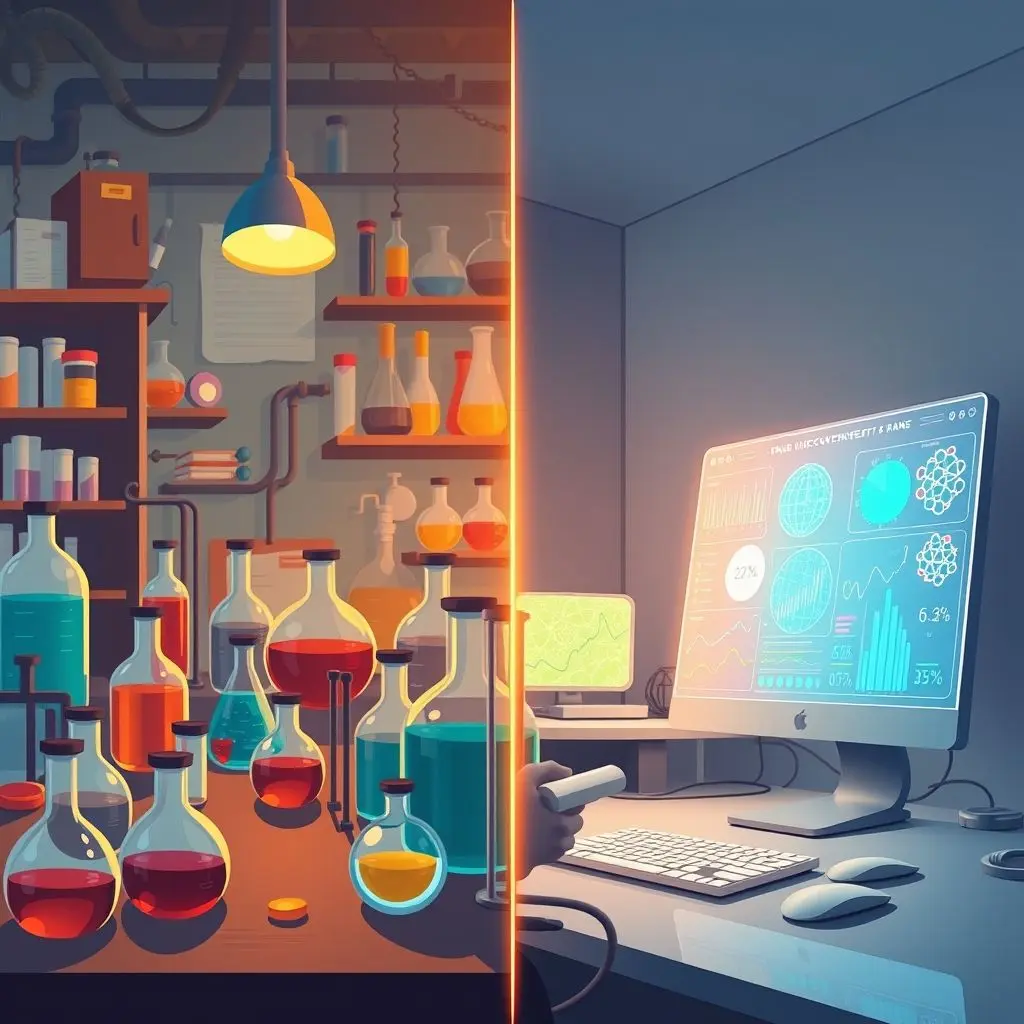Okay, picture this: the next medicine that could change lives isn’t just the result of countless hours spent painstakingly mixing chemicals in a lab. What if a significant part of its journey, from idea to potential treatment, was guided and accelerated by… well, a computer? That might sound like something out of a futuristic movie, but the reality is, artificial intelligence (AI) is rapidly becoming a powerful force in the world of drug discovery, fundamentally changing how we search for new therapies.
Traditional drug discovery is notoriously slow, incredibly expensive, and has a high failure rate. It can take over a decade and cost billions of dollars to bring a single new drug to market, with many promising candidates failing during clinical trials. It’s a complex puzzle involving understanding diseases at a molecular level, finding molecules that can interact with specific biological targets, and ensuring they are safe and effective in humans.
Speaking of these mind-bending possibilities, sometimes seeing is believing. Take a quick look at this:
Pretty wild, right? The notion of algorithms sifting through vast datasets and predicting molecular behavior isn’t just theoretical; it’s happening now, pushing the boundaries of what’s possible.
Table of Contents
Why is AI Such a Game Changer for Medicines?
The sheer scale and complexity of biological and chemical data are immense. Consider the human genome, the structure of millions of molecules, the intricate pathways within cells, and the results of countless experiments and clinical trials. Humans, even working in large teams, struggle to process and find meaningful patterns within this ocean of information efficiently. This is where AI excels.
AI algorithms, particularly those based on machine learning and deep learning, are adept at identifying complex patterns, making predictions, and even generating novel ideas from massive datasets. By applying these capabilities to the different stages of drug discovery, AI offers the potential to significantly accelerate the process, reduce costs, and improve success rates.

How AI is Being Applied Across the Drug Discovery Pipeline
AI isn’t just one magic bullet; it’s a suite of tools being integrated into multiple steps of the drug discovery and development process:
1. Target Identification and Validation
Before you can find a drug, you need to identify the specific biological target (like a protein or a gene) that plays a key role in a disease. AI can analyze genomic data, protein structures, scientific literature, and clinical data to pinpoint potential targets and predict their involvement in disease pathways. This helps researchers prioritize the most promising targets to focus on.
2. Molecule Design and Generation (De Novo Design)
Instead of just screening existing libraries of compounds, AI models can learn the rules of chemistry and biology to *generate* entirely new molecular structures predicted to have desired properties, such as binding strongly to a specific target. This ‘de novo’ design process can lead to novel compounds that might never have been conceived through traditional methods.
3. Compound Screening and Binding Prediction
Identifying potential drug candidates often involves screening millions of compounds to see which ones might interact with the chosen biological target. AI can predict how strongly a molecule will bind to a target based on their structures, significantly narrowing down the list of candidates that need to be physically tested. This process, known as virtual screening, saves immense time and resources compared to high-throughput screening alone.

4. Predicting ADMET Properties
Once a potential drug candidate is identified, it’s crucial to know how it will behave in the human body – how it’s absorbed, distributed, metabolized, excreted, and its potential toxicity (ADMET). Predicting these properties early on is critical because poor ADMET characteristics are a major reason for drug failures. AI models trained on vast experimental data can predict these properties for new molecules with increasing accuracy, helping filter out problematic compounds sooner.
5. Optimizing Synthesis and Manufacturing
Even after a promising molecule is found, synthesizing it in the lab and scaling up for manufacturing can be challenging. AI can help predict the best chemical reactions and pathways for synthesizing complex molecules, optimizing yields and reducing waste.
6. Clinical Trial Design and Patient Selection
AI is also making inroads into the clinical stage. It can analyze patient data to identify specific subgroups who are most likely to respond to a treatment, improving trial efficiency and potentially increasing success rates. AI can also help optimize trial design and predict trial outcomes based on historical data.
The Tangible Benefits: Speed, Cost, and Accuracy
Bringing AI into the fold isn’t just a technological flex; it offers concrete advantages:
- Accelerated Timelines: Tasks that used to take months or years of manual experimentation, like screening millions of compounds or predicting molecular properties, can potentially be done in weeks or days by AI.
- Reduced Costs: By accelerating processes and reducing late-stage failures (which are the most expensive), AI can significantly lower the overall cost of R&D.
- Improved Accuracy and Success Rates: Better prediction of efficacy and safety earlier in the process can lead to fewer failures in preclinical and clinical stages.
- Discovering Novel Chemistry: AI can explore chemical space more broadly than humans, potentially leading to entirely new classes of drugs.
- Tackling Complex Diseases: AI is particularly valuable for diseases with complex biological underpinnings, where traditional ‘one-target, one-drug’ approaches have been less successful.

Challenges on the Horizon
While the promise is huge, AI in drug discovery isn’t without its hurdles:
- Data Quality and Availability: AI needs vast amounts of high-quality, well-annotated data to learn effectively. Biological data can be messy, incomplete, or proprietary.
- Interpretability (The ‘Black Box’): Some powerful AI models, particularly deep learning networks, can be difficult to interpret. Understanding *why* an AI made a certain prediction about a molecule is crucial for scientists who need to validate and build upon those findings.
- Regulatory Approval: Regulatory bodies like the FDA are still developing frameworks for evaluating drugs discovered or designed primarily through AI.
- Integration into Existing Workflows: Integrating AI tools seamlessly into existing research labs and pharmaceutical company structures requires significant investment and cultural change.
- Computational Resources: Training complex AI models and processing massive datasets requires significant computational power.
Real-World Momentum: AI Companies Leading the Charge
Numerous biotech and pharmaceutical companies are now leveraging AI. Some, like Exscientia, BenevolentAI, and Recursion Pharmaceuticals, are AI-native companies building platforms specifically for drug discovery. Others, like major pharmaceutical giants, are integrating AI tools and capabilities into their existing R&D pipelines. The success of projects like DeepMind’s AlphaFold in accurately predicting protein structures (fundamental targets for many drugs) further underscores the power of AI in understanding the biological world.
Looking Ahead: A Healthier Future, Faster?
The application of AI in drug discovery is still relatively young, but its impact is undeniable and growing rapidly. It’s not about replacing human scientists but augmenting their capabilities, freeing them up to focus on higher-level experimental design and validation. As AI models become more sophisticated, access to data improves, and computational power increases, we can expect AI to play an even more central role in identifying, designing, and testing the medicines of tomorrow.
This convergence of artificial intelligence and life sciences holds the potential to dramatically accelerate the pace at which we discover new treatments for diseases that currently have limited options, ultimately bringing potentially life-saving therapies to patients much, much sooner than previously possible.
Frequently Asked Questions
Q: Does AI design the entire drug by itself?
A: Not entirely. AI is a powerful tool that assists human scientists. It can analyze data, predict properties, and propose molecules, but human expertise is still essential for setting research goals, validating AI predictions, conducting experiments, and overseeing clinical trials.
Q: Are AI-discovered drugs already on the market?
A: While many companies are using AI in their R&D pipelines, bringing a drug through the entire process to market takes many years. The first drugs *primarily* discovered and designed using AI are starting to enter clinical trials, and we may see them on the market in the coming years if they prove safe and effective.
Q: Is AI only for finding new drugs, or can it improve existing ones?
A: AI can do both. It can help identify novel compounds for new targets, and it can also be used to find new uses for existing drugs (drug repurposing) or to optimize the structure and properties of compounds that are already known.
Q: Will AI make drugs cheaper?
A: By potentially reducing the time and cost of R&D and decreasing the high failure rate, AI has the potential to lower the overall cost of bringing a drug to market. However, the final price of a drug is influenced by many factors beyond R&D costs, including manufacturing, marketing, and market exclusivity.





